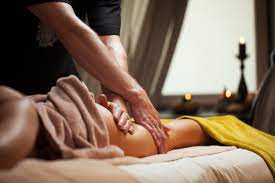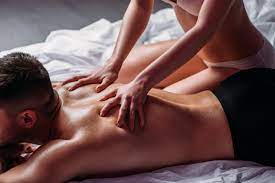Performing sensual tantric massage involves combining massage techniques with the use of essential oils to promote relaxation and well-being. Here is a general guide on how to perform sensual tantric massage:
Materials Needed:
Massage oil: Choose a carrier oil, such as sweet almond, jojoba, or coconut oil. You’ll mix this with essential oils.
Essential oils: Select essential oils based on the desired effects. For relaxation, lavender or chamomile may be suitable, while peppermint or eucalyptus can be invigorating.
Towels: Have a couple of towels available to cover and keep the client comfortable.
Massage table or comfortable surface: Ensure a comfortable and stable area for the massage.
Steps:
Consultation: Begin by consulting with the client about any health conditions, preferences, and concerns. This helps you choose appropriate essential oils and tailor the massage to their needs.
Prepare the Room: Create a relaxing environment with dim lighting, soothing music, and a comfortable temperature.
Prepare the Massage Oil: Mix the chosen carrier oil with a few drops of selected essential oils. The typical dilution ratio is about 1-3% essential oil to carrier oil, depending on the specific essential oil and individual sensitivity.
Ask the Client to Undress: Instruct the client to undress to their level of comfort and lie on the massage table, covered with a towel.
Start with Relaxation Techniques: Begin the massage with gentle relaxation techniques, such as effleurage (long, sweeping strokes) to warm up the muscles.
Apply the Sensual tantric Oil: Pour a small amount of the sensual tantric oil blend into your hands and warm it by rubbing your palms together. Apply the oil to the client’s skin using long, flowing strokes.
Incorporate Various Massage Techniques: Use a combination of massage techniques such as kneading, petrissage, and circular motions to target different muscle groups and promote relaxation.
Focus on Sensual erotic zones: Pay attention to specific sensual zone or areas of tension while incorporating the sensual tantric oil. For example, the neck, shoulders, and back are common areas for tension relief.
Be Mindful of the Client’s Comfort: Check in with the client regularly regarding pressure and comfort. Adjust your techniques accordingly.
Complete the Massage: Gradually wind down the massage with lighter strokes. Allow the client a few moments to rest and relax after the massage.
Provide Post-Massage Care: Offer water to help flush out toxins and advise the client to take it easy for a little while to fully enjoy the benefits of the massage.
Always consider the individual needs and preferences of the client, and be aware of any contraindications or allergies they may have. If you’re not a trained massage therapist or tantric therapist, it’s advisable to seek guidance or training before attempting sensual tantric massage on others. Additionally, pregnant individuals or those with certain health conditions should consult with a healthcare professional before receiving sensual tantric massage.

Physical and spiritual benefits of tantric massage
Sensual tantric massage combines massage techniques with the use of essential oils to enhance physical and mental well-being. While individual responses may vary, there are several potential health benefits associated with sensual tantric massage:
Stress Reduction: Sensual tantric massage can help reduce stress and promote relaxation. The combination of gentle massage and the inhalation of soothing essential oils can have a calming effect on the nervous system.
Improved Sleep: Certain essential oils, such as lavender and chamomile, are known for their sedative properties. Sensual tantric massage with these oils may help improve sleep quality and alleviate insomnia.
Pain Relief: Massage itself can help alleviate muscle tension and reduce pain. When combined with certain analgesic essential oils like peppermint or eucalyptus, the massage may provide additional relief for sore muscles and joints.
Enhanced Mood: Sensual tantric is believed to influence mood through the limbic system, which is involved in emotions and memory. Essential oils like citrus oils (e.g., bergamot, orange) are often used to uplift mood and reduce feelings of anxiety or depression.
Improved Circulation: Tantric touch promotes blood circulation, and certain essential oils like ginger or black pepper may further enhance this effect. Improved circulation can have positive effects on various bodily functions and promote overall well-being.
Immune System Support: Some essential oils possess antimicrobial properties that may help support the immune system. Oils like tea tree, eucalyptus, and thyme are known for their potential antimicrobial effects.
Headache Relief: Sensual tantric massage targeting the neck, shoulders, and head can be beneficial for relieving tension headaches. Essential oils like peppermint or lavender may be used for their soothing and analgesic properties.
Improved Skin Health: Certain essential oils, such as tea tree and chamomile, have skin-nourishing properties. When incorporated into massage oils, they may contribute to improved skin health and hydration.
It’s important to note that individual responses to sensual tantric massage can vary, and the effectiveness of the treatment may depend on factors such as the choice of essential oils, the individual’s preferences, and any underlying health conditions. Before undergoing sensual tantric massage, it’s advisable to consult with a qualified tantric therapist or healthcare professional, especially if you have any specific health concerns or are hypertension.
